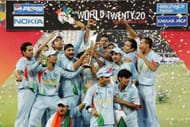Impact of the 2007 T20 World Cup
March 2007. India crash out in the group stages of the 50 over World Cup in the West Indies. This is a big deal. There is a huge uproar in India. The players’ houses are attacked, their effigies are burnt. India has gone berserk. Greg Chappell is sacked. The players’ heads are called for. Accusations of match fixing are rife.
September 2007. The T20 World Cup begins. India come in to this tournament having played all of one T20 international. Their first match is a washout against Scotland. The second one against Pakistan ends in a tie. India win via a bowl out. In the Super8 stage, India lose their first match against New Zealand after scoring over 200 runs. In the next match against England, Yuvraj Singh smashes six sixes in an over. The cricket loving population of India goes crazy. Yuvraj wins millions of new fans. The match against South Africa is a must win game. India’s bowlers win it for them. RP Singh takes 4 wickets, Dinesh Karthik, one of the best catches in the history of the game. India face Australia in the semi final. Yuvraj scores a 30 ball 70. Australia are thrashed. The popularity of the format skyrockets in the space of two weeks. India has fallen in love with T20 cricket, so have the administrators and the businessmen, sensing something very big. While India prepares to take on arch rivals Pakistan in the final in Johannesburg, plans are being made to launch two T20 leagues in India.
The Zee Entertainment Enterprises(ZEE) is about to launch the private Indian Cricket League(ICL), while businessman and sports administrator Lalit Modi is coming up with the idea of a BCCI run Indian Premier League(IPL).
As India wins the final, the joy amongst the people of the country is unbelievable. This victory makes up for the early exit in the 50 over World Cup. It makes up for the numerous losses India had faced in the recent years. It makes up for the fact that India had not won an ICC event for 24 years. It makes up for it all.
Lalit Modi is there at the stadium, smiling when India takes the last Pakistani wicket. He knows how cricket is going to change in the next couple of months. He knows that he’s the man who is going to change cricket. He knows that the IPL, his brainchild is going to change cricket. He knows that the T20 World Cup, which seems so big right now, will cease to matter, will not be given any importance in the coming few years, once the IPL takes off. He knows that the ICL will fail, for he will use his might to get it classified as a rebel league. He knows that the IPL will not face any competition. As he applauds the Indian team, he knows all of that.
T20 cricket in India - The ICL and the IPL
The ICL started in late 2007. It didn’t turn out the way ZEE had imagined it would. There were no star players, there was not much hype, there was not much money, there was not much to write home about. The BCCI had declared it as a rebel league, banning anyone who joined it from playing the Ranji Trophy, thereby disassociating them from Indian Cricket. A few players, those who knew they wouldn’t play for India, those who wanted some financial stability joined, but it never really took off. It never reached the heights it was expected to and was scrapped in 2009, after just two seasons.
The IPL, thus was without any competition when it was launched. It was the one single event which revolutionised the game of cricket. Cricket became more than just a mere sport. It became a business, it became an industry, it became something which had to be marketed. It had to, because of all the money involved, because of the kind of people involved in it. The owners, who invested hundreds of crores in buying their franchises, ranged from Bollywood actors to business tycoons and corporate companies. When sport is not looked at as just a sport, the players are also not looked at as just players. They became entities, who were bought and sold in the auctions. And they were paid a hell of a lot of money, amounts which had never been heard of.
Everyone loved it. As IPL 8’s slogan says, it became a festival in India. People, young and old, girls and boys, rich and poor, were all brought together in a way never seen before. Stadiums were packed, the television viewership was breaking all-time records, the amount of investment made by companies was humongous, the revenue earned through advertisements was extremely high. The IPL had everything going for it. It succeeded, financially or in commercial terms, like no other event in cricketing history had. It has had eight seasons until now and the craze hasn’t diminished. The fourth season, immediately after the 2011 World Cup was the only one that has failed. It’s been that successful, just one failed season in eight.
The success of this tournament has given rise to various IPL style leagues around the world. Australia, South Africa, Bangladesh, Sri Lanka, West Indies, England, Pakistan have all come up with leagues of their own.
If you compare football with cricket, you will find one striking difference. In football, a lot of importance is attached to club games, much more than International matches. Whereas, in cricket, clubs didn’t exist until the IPL came about. International cricket was all there was.
There’s a reason more people watch football. Matches get over in 90 minutes flat. One dayers take 420. What the IPL is doing is basically making the game easier to promote by following the football model. T20 internationals do not have much importance now. It’s mostly just the IPL’s and the Ram Slam’s that people talk. The frequency with which the T20 World Cup takes place has greatly reduced it’s importance. On the contrary, the infrequency of bilateral T20 internationals suggests the fact that it is not looked upon as a viable option. The club matches are played in the evenings, only last for three hours, the batsmen slog, the crowds are entertained and a lot of money is made. T20 is the first format in which domestic, club games are given more importance than Internationals. It’s clear that this is the beginning of the ‘footballisation’ of the game. T20 affords us that luxury. ODI and Test Cricket, not so much. Not much at all.
There’s a reason to adding 2003 or 2008 to the list containing the years 1877 and 1971. 2003 should be added because it was when T20 cricket started. 2008 should be added because it was when club cricket started, it was when club cricket became important, it was when the game got revolutionised. 2005 not so because it contained the first T20 international. In the present context, it’s not of much value, is it? That’s how far T20 has come. That’s how far T20 has brought the game. It has made club games more valuable than internationals. It’s just the beginning. There’s a lot more it can do. Once that is achieved, something else will come up, and this cycle of change will go on.
Follow IPL Auction 2025 Live Updates, News & Biddings at Sportskeeda. Get the fastest updates on Mega-Auction and cricket news


